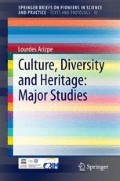Abstract
Great cultures have lived together for millennia, at times in conflict, at times in harmony. History reminds us that great works of ancient architecture, like the Lighthouse of Alexandria or the Coliseum of Rome, remain universal even if lost. And much cultural heritage still lies under the sea, so many seas, to be rediscovered and remembered.
Access this chapter
Tax calculation will be finalised at checkout
Purchases are for personal use only
Notes
- 1.
This paper is based on a Conference on ‘Cultural Heritage and Development’ and was delivered at the Library of Alexandria, Egypt, 25 April 2009. Unpublished. I am greatly indebted to Michael Cernea, who had a leadership role in cultural heritage and development programmes at the World Bank, for his valuable suggestions for this paper.
- 2.
See at: <http://whc.unesco.org/en/conventiontext/> (8 August 2014).
- 3.
“Radical Islamists Wage Muslim Civil War in Africa”, by Melik Kaylan, in: The Wall Street Journal, 14 July 2012, at: <http://www.afes-press-books.de/html/hexagon.htm> (6 August 2014): A13.
- 4.
See “Intangible Heritage”, in: Museum International (October 2004), at: <http://portal.unesco.org/culture/en/ev.php-URL_ID=21739&URL_DO=DO_TOPIC&URL_SECTION=201.html> (8 August 2014).
- 5.
This was taken from Nelson Mandela’s image of the ‘Rainbow Nation’ for South Africa.
- 6.
Exact figures concerning languages are always controversial since they will vary enormously according to whether a language is classified as such or as a sub-variant of another.
- 7.
One can only imagine the extraordinary monuments and palaces built with sand or wood that have been destroyed over history.
- 8.
See Blake (2001).
References
Appiah, Kwame Anthony, 2004: “Culture and Development”, Paper for the UNDP Meeting for the Human Development Report, New York, 20 September.
Arizpe, Lourdes, 1989: “On the Social and Cultural Sustainability of World Development”, in: Emmerij, Louis (Ed.): One World or Several? (Paris: OECD Development Centre): 207–219.
Arizpe, Lourdes, 2000: “Cultural Heritage and Globalization”, in: Erica, Avrami; Randall, Mason; Marta de la Torre (Eds.): Values and Heritage Conservation: Research Report (Los Angeles: The Getty Conservation Institute): 32–37.
Blake, Janet, 2001: Developing a New Standard-Setting Instrument for the Safeguarding of Intangible Heritage (Paris: UNESCO).
Breckenridge, Carol; Pollock, Sheldon; Bhabha, Homi; Chakrabarty, Dipesh (Eds.), 2002: Cosmopolitanism (Durham: Duke University Press).
Cernea, Michael M., 2000: Cultural Heritage Preservation and Management in the MENA Region. Sector Review (Washington: World Bank).
Cernea, Michael M., 2001: Cultural Heritage and Development: A Framework for Action in the Middle East and North Africa (Washington: World Bank).
Cernea, Michael M., 2003: Patrimoine culturel et développement: Cadre d’action pour le Moyen-Orient et l’Afrique du Nord (Washington: Banque Mondiale).
Condominas, George, 2004: “Researching and Safeguarding the Intangible Heritage”, in: Museum International, 56, 1–2 (May): 21–32.
Cowen, Tylor, 2003: Creative Destruction: How Globalization is Changing the World’s Cultures (Princeton: Princeton University Press).
Jolly, Richard, 2003: “Human development and neoliberalism: paradigms compared”, in: Fukuda-Parr, Sakiko; Shiva Kumar, A. K. (Eds.): Readings in Human Development: Concepts, Measures, and Policy for a Development (New Delhi: Oxford University Press): 82–92.
Kaul, Inge (Ed.), 2003: Providing Global Public Goods: Managing Globalization (Oxford: Oxford University Press).
Maalouf, Amin, 1997: Les Identités Meurtrières (Paris: Flammarion).
Munjeri, Dawson, 2004: “Tangible and Intangible Heritage: From Difference to Convergence”, in: Museum International, 56, 1–2 (May): 12–20.
Portes, Alejandro, 2002: “English-Only Triumphs, but the Costs are High”, in: Contexts, 1 (Spring): 10–15.
Robertson, Roland, 1992: Globalization: Social Theory and Global Culture (London: Sage).
Sarbib, Jean-Louis, 2001 (OJO not 2003): “Foreword”, in: Cernea, Michael M. (Ed.): Cultural Heritage and Development: A Framework for Action in the Middle East and North Africa (Washington: World Bank): vii–viii.
Sen, Amartya, 2006: Identity and Violence: The Illusion of Destiny (London: WW Norton and Co.).
Serageldin, Ismail; Martin-Brown, Joan (Eds.), 1999: Culture in Sustainable Development: Investing in Cultural and Natural Endowments (Washington: World Bank).
Serageldin, Ismail; Shluger, Ephim; Martin-Brown, Joan (Eds.), 2001: Historic Cities and Sacred Sites: Cultural Roots for Urban Futures (Washington: World Bank).
United Nations Educational, Scientific and Cultural Organization (UNESCO), 1994: Red Book of the World’s Endangered Languages (Paris: UNESCO).
United Nations Educational, Scientific and Cultural Organization, 1995: Our Creative Diversity (Paris: Culture and Development Co-ordination Office).
United Nations Educational, Scientific and Cultural Organization (UNESCO), 1998a: Intergovernmental Conference on Cultural Policies for Development. Stockholm. Final Report (Paris: UNESCO).
United Nations Educational, Scientific and Cultural Organization (UNESCO), 1998b: World Culture Report: Culture, Creativity and Markets (Paris: UNESCO).
United Nations Educational, Scientific and Cultural Organization (UNESCO), 2000: World Culture Report: Cultural Diversity Conflict and Pluralism (Paris: UNESCO).
United Nations Educational, Scientific and Cultural Organization (UNESCO), 2001: Atlas of the World’s Languages in Danger (Paris: UNESCO).
United Nations Educational, Scientific and Cultural Organization (UNESCO), 2003: Convention for the Safeguarding of Intangible Cultural Heritage (Paris: UNESCO).
Wagner, Peter, 1999: “The Twentieth Century: The Century of the Social Sciences?”, in: Kazancigil, Ali; Matkinson, David: World Social Science Report (Paris: UNESCO): 19–41.
Wolfensohn, James D.; Dini, Lamberto; Facco-Bonetti, Gianfranco; Johnson, Ian; Martin-Brown, Joan, 2000: Culture Counts: Financing, Resources, and the Economics of Culture in Sustainable Development (Washington: World Bank).
World Commission on the Social Dimensions of Globalization (WCSDG), 2004: A Fair Globalization: Creating Opportunities for All (Geneva: ILO).
Author information
Authors and Affiliations
Corresponding author
Rights and permissions
Copyright information
© 2015 The Author(s)
About this chapter
Cite this chapter
Arizpe, L. (2015). Cultural Endowments at Risk in Induced Development. In: Culture, Diversity and Heritage: Major Studies. SpringerBriefs on Pioneers in Science and Practice(), vol 12. Springer, Cham. https://doi.org/10.1007/978-3-319-13811-4_9
Download citation
DOI: https://doi.org/10.1007/978-3-319-13811-4_9
Published:
Publisher Name: Springer, Cham
Print ISBN: 978-3-319-13810-7
Online ISBN: 978-3-319-13811-4
eBook Packages: Humanities, Social Sciences and LawPolitical Science and International Studies (R0)

